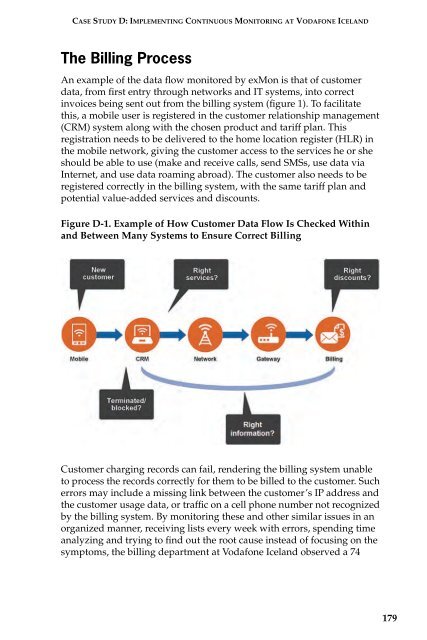- Page 1 and 2:
AUDIT ANALYTICS and CONTINUOUS AUDI
- Page 3 and 4:
Notice to Readers Audit Analytics a
- Page 6 and 7:
TABLE OF CONTENTS Preface Acknowled
- Page 8 and 9:
CONTENTS 3 Evolution of Auditing: F
- Page 10:
CONTENTS B Page Implementing Contin
- Page 13 and 14:
AUDIT ANALYTICS AND CONTINUOUS AUDI
- Page 16 and 17:
AUTHOR BIOGRAPHIES Abdullah Alawadh
- Page 18 and 19:
AUTHOR BIOGRAPHIES He is a passiona
- Page 20 and 21:
AUTHOR BIOGRAPHIES AICPA Assurance
- Page 22 and 23:
AUTHOR BIOGRAPHIES management. Prio
- Page 24 and 25:
AUTHOR BIOGRAPHIES Trevor R. Stewar
- Page 26:
PART I Essays 1
- Page 29 and 30:
AUDIT ANALYTICS AND CONTINUOUS AUDI
- Page 31 and 32:
AUDIT ANALYTICS AND CONTINUOUS AUDI
- Page 33 and 34:
AUDIT ANALYTICS AND CONTINUOUS AUDI
- Page 35 and 36:
AUDIT ANALYTICS AND CONTINUOUS AUDI
- Page 37 and 38:
AUDIT ANALYTICS AND CONTINUOUS AUDI
- Page 39 and 40:
AUDIT ANALYTICS AND CONTINUOUS AUDI
- Page 41 and 42:
AUDIT ANALYTICS AND CONTINUOUS AUDI
- Page 43 and 44:
AUDIT ANALYTICS AND CONTINUOUS AUDI
- Page 45 and 46:
AUDIT ANALYTICS AND CONTINUOUS AUDI
- Page 47 and 48:
AUDIT ANALYTICS AND CONTINUOUS AUDI
- Page 49 and 50:
AUDIT ANALYTICS AND CONTINUOUS AUDI
- Page 51 and 52:
AUDIT ANALYTICS AND CONTINUOUS AUDI
- Page 53 and 54:
AUDIT ANALYTICS AND CONTINUOUS AUDI
- Page 55 and 56:
AUDIT ANALYTICS AND CONTINUOUS AUDI
- Page 57 and 58:
AUDIT ANALYTICS AND CONTINUOUS AUDI
- Page 59 and 60:
AUDIT ANALYTICS AND CONTINUOUS AUDI
- Page 61 and 62:
AUDIT ANALYTICS AND CONTINUOUS AUDI
- Page 63 and 64:
AUDIT ANALYTICS AND CONTINUOUS AUDI
- Page 65 and 66:
AUDIT ANALYTICS AND CONTINUOUS AUDI
- Page 67 and 68:
AUDIT ANALYTICS AND CONTINUOUS AUDI
- Page 69 and 70:
AUDIT ANALYTICS AND CONTINUOUS AUDI
- Page 71 and 72:
AUDIT ANALYTICS AND CONTINUOUS AUDI
- Page 73 and 74:
AUDIT ANALYTICS AND CONTINUOUS AUDI
- Page 75 and 76:
AUDIT ANALYTICS AND CONTINUOUS AUDI
- Page 77 and 78:
AUDIT ANALYTICS AND CONTINUOUS AUDI
- Page 79 and 80:
AUDIT ANALYTICS AND CONTINUOUS AUDI
- Page 81 and 82:
AUDIT ANALYTICS AND CONTINUOUS AUDI
- Page 83 and 84:
AUDIT ANALYTICS AND CONTINUOUS AUDI
- Page 85 and 86:
AUDIT ANALYTICS AND CONTINUOUS AUDI
- Page 87 and 88:
AUDIT ANALYTICS AND CONTINUOUS AUDI
- Page 89 and 90:
AUDIT ANALYTICS AND CONTINUOUS AUDI
- Page 91 and 92:
AUDIT ANALYTICS AND CONTINUOUS AUDI
- Page 93 and 94:
AUDIT ANALYTICS AND CONTINUOUS AUDI
- Page 95 and 96:
AUDIT ANALYTICS AND CONTINUOUS AUDI
- Page 97 and 98:
AUDIT ANALYTICS AND CONTINUOUS AUDI
- Page 99 and 100:
AUDIT ANALYTICS AND CONTINUOUS AUDI
- Page 101 and 102:
AUDIT ANALYTICS AND CONTINUOUS AUDI
- Page 103 and 104:
AUDIT ANALYTICS AND CONTINUOUS AUDI
- Page 105 and 106:
AUDIT ANALYTICS AND CONTINUOUS AUDI
- Page 107 and 108:
AUDIT ANALYTICS AND CONTINUOUS AUDI
- Page 109 and 110:
AUDIT ANALYTICS AND CONTINUOUS AUDI
- Page 112 and 113:
ESSAY 4 Reimagining Auditing in a W
- Page 114 and 115:
ESSAY 4: REIMAGINING AUDITING IN A
- Page 116 and 117:
ESSAY 4: REIMAGINING AUDITING IN A
- Page 118 and 119:
ESSAY 4: REIMAGINING AUDITING IN A
- Page 120 and 121:
ESSAY 4: REIMAGINING AUDITING IN A
- Page 122 and 123:
ESSAY 4: REIMAGINING AUDITING IN A
- Page 124 and 125:
ESSAY 4: REIMAGINING AUDITING IN A
- Page 126 and 127:
ESSAY 4: REIMAGINING AUDITING IN A
- Page 128:
ESSAY 4: REIMAGINING AUDITING IN A
- Page 131 and 132:
AUDIT ANALYTICS AND CONTINUOUS AUDI
- Page 133 and 134:
AUDIT ANALYTICS AND CONTINUOUS AUDI
- Page 135 and 136:
AUDIT ANALYTICS AND CONTINUOUS AUDI
- Page 137 and 138:
AUDIT ANALYTICS AND CONTINUOUS AUDI
- Page 139 and 140:
AUDIT ANALYTICS AND CONTINUOUS AUDI
- Page 141 and 142:
AUDIT ANALYTICS AND CONTINUOUS AUDI
- Page 143 and 144:
AUDIT ANALYTICS AND CONTINUOUS AUDI
- Page 145 and 146:
AUDIT ANALYTICS AND CONTINUOUS AUDI
- Page 147 and 148:
AUDIT ANALYTICS AND CONTINUOUS AUDI
- Page 149 and 150:
AUDIT ANALYTICS AND CONTINUOUS AUDI
- Page 151 and 152:
AUDIT ANALYTICS AND CONTINUOUS AUDI
- Page 153 and 154: AUDIT ANALYTICS AND CONTINUOUS AUDI
- Page 155 and 156: AUDIT ANALYTICS AND CONTINUOUS AUDI
- Page 157 and 158: AUDIT ANALYTICS AND CONTINUOUS AUDI
- Page 159 and 160: AUDIT ANALYTICS AND CONTINUOUS AUDI
- Page 161 and 162: AUDIT ANALYTICS AND CONTINUOUS AUDI
- Page 163 and 164: AUDIT ANALYTICS AND CONTINUOUS AUDI
- Page 165 and 166: AUDIT ANALYTICS AND CONTINUOUS AUDI
- Page 167 and 168: AUDIT ANALYTICS AND CONTINUOUS AUDI
- Page 170: PART II Case Studies 145
- Page 173 and 174: AUDIT ANALYTICS AND CONTINUOUS AUDI
- Page 175 and 176: AUDIT ANALYTICS AND CONTINUOUS AUDI
- Page 177 and 178: AUDIT ANALYTICS AND CONTINUOUS AUDI
- Page 179 and 180: AUDIT ANALYTICS AND CONTINUOUS AUDI
- Page 182 and 183: CASE STUDY B Implementing Continuou
- Page 184 and 185: CASE STUDY B: IMPLEMENTING CONTINUO
- Page 186 and 187: CASE STUDY B: IMPLEMENTING CONTINUO
- Page 188 and 189: CASE STUDY B: IMPLEMENTING CONTINUO
- Page 190 and 191: CASE STUDY B: IMPLEMENTING CONTINUO
- Page 192: CASE STUDY B: IMPLEMENTING CONTINUO
- Page 195 and 196: AUDIT ANALYTICS AND CONTINUOUS AUDI
- Page 197 and 198: AUDIT ANALYTICS AND CONTINUOUS AUDI
- Page 200 and 201: CASE STUDY D Implementing Continuou
- Page 202 and 203: CASE STUDY D: IMPLEMENTING CONTINUO
- Page 206 and 207: CASE STUDY D: IMPLEMENTING CONTINUO
- Page 208 and 209: CASE STUDY D: IMPLEMENTING CONTINUO
- Page 210: AICPA Assurance Services Executive


